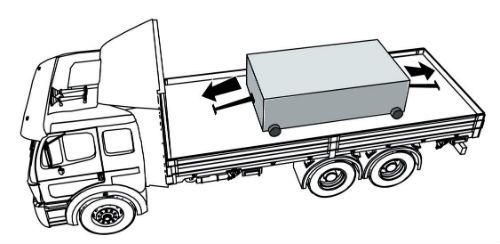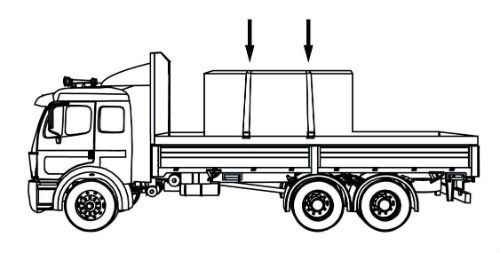CDL Practice Tests: Flatbed Cargo Securement
Choose A Section:
Go!The narrowest end of a boulder should be pointed:
- Towards the front of the vehicle.
- Towards the sky.
- It doesn't matter.
- Towards the rear of the vehicle.

If a boulder is tapered, point the narrowest end towards the front of the vehicle.
When securing paper rolls with eyes vertical in a sided vehicle all of the following are acceptable except:
- Placing the rolls against each other.
- Placing the rolls against other cargo.
- Placing rolls against the doors.
- Placing rolls against the front and walls of the vehicle.
- Place paper rolls together in a group so that the structure of the group can be maintained.
- Place paper rolls against:
- The front and walls of the vehicle
- Each other
- Other cargo
In terms of cargo securement, what is a 'well'?
- The depression formed between two cylindrical articles when they are laid with their eyes horizontal and parallel against each other.
- A rail along the side of a vehicle that protects the side of the vehicle from impacts.
- A device placed between the deck of a vehicle and car or between articles of cargo, intended to provide greater friction than exists naturally between these surfaces.
- A female housing fixed to the side or ends of a vehicle to receive a stake or peg, and may also be used as an anchor point.
Well:
The depression formed between two cylindrical articles when they are laid with their eyes horizontal and parallel against each other.
Requirements for securing heavy vehicles, equipment, and machinery apply at what weight?
- Less than 10,000 lbs
- 50% the weight of the trailer
- More than 10,000 lbs
- More than 4,500 lbs
What Does This Section Cover?
The requirements in this section apply to the transportation of heavy vehicles, equipment, and machinery that:
- Operate on wheels or tracks, such as front end loaders, bulldozers, tractors, and power shovels.
- Individually weigh more than 4500 kg (10,000 lb.).
When securing concrete pipe with a diameter up to 45 inches loaded crosswise as a group, a crosswise tiedown should be used every how many feet?
- 6
- 10
- 3
- 15
As a group
Place lengthwise tiedowns over the group of pipes:
Either one 13 mm (1/2 in) chain or wire rope,
Or two 10 mm (3/8 in) diameter chain or wire rope
Place one crosswise tiedown for every 3.0 m (10 ft) of load length.

Either attach the side-to-side tiedown through a pipe
Or pass the tiedown over both front-to-back tiedowns between two pipes on the top tier.
What is the minimum WLL required of tiedowns securing loaded intermodal containers on non-chassis vehicles?
- It depends on the length of the container.
- 20% of the loaded weight of the container.
- 50% of the loaded weight of the container.
- 80% of the loaded weight of the container.
Secure each container to the vehicle by:
- Either chains, wire ropes, or integral devices that are fixed to all lower corners.
- Or crossed chains that are fixed to all upper corners.
- Or both.
Secure the front and rear of the loaded container independently.
Secure the four corners using tiedowns that are attached to the loaded container.
The tiedowns must have an aggregate working load limit of at least 50% of the loaded weight of the loaded container.
Attach each chain, wire rope, or integral locking device to the container in a manner that prevents it from becoming unfastened while in transit.
A dunnage bag is:
- A waterproof sheet used to cover cargo.
- A structure, device, or another substantial article placed against or around an article to prevent horizontal movement of the article.
- A transverse load bearing structural component, particularly a part of a log bunk.
- An inflatable bag intended to fill otherwise empty space between articles of cargo, or between articles of cargo and the wall of the vehicle.
Dunnage bag:
An inflatable bag intended to fill otherwise empty space between articles of cargo, or between articles of cargo and the wall of the vehicle.
All of the following are requirements for transporting coils with eyes crosswise except:
- Attach one tiedown forward
- Prevent the coil from rolling
- Attach one tiedown rearward
- These are all requirements
There are three requirements for coils transported with eyes crosswise:

Prevent the coil from rolling
Attach one tiedown forward.
Attach one tiedown rearward.
What is the minimum weight of a shipment of paper rolls that would require specific securement requirements?
- 5,000 lbs
- It depends on how they're loaded
- 2,268 lbs
- 10,000 lbs
The rules in this section apply to shipments of paper rolls, which individually or together, weigh 2268 kg (5000 lb.) or more.
Note: Shipments of paper rolls that weigh less than 2268 kg (5000 lb.), and paper rolls that are unitized on a pallet may either be secured in accordance this section or with the general cargo securement requirements
When calculating directional forces, 'g' is expressed as:
- The maximum load that may be applied to a component of a cargo securement system during normal service, usually assigned by the manufacturer of the component.
- The summation of the working load limits or restraining capacity of all devices used to secure an article on a vehicle.
- The maximum load that may be applied to a component of a cargo securement system during normal service, usually assigned by the manufacturer of the component.
- The acceleration due to gravity, 9.823 m/sec2 (32.2 ft/sec2). For cargo securement purposes it is expressed as a percentage of cargo weight, i.e. .5g is 50% of force of gravity or 50% of cargo weight.
g:
The acceleration due to gravity, 9.823 m/sec2 (32.2 ft/sec2). For cargo securement purposes it is expressed as a percentage of cargo weight, i.e. .5g is 50% of force of gravity or 50% of cargo weight.
About The Flatbed Cargo Securement CDL Manual
Studying the flatbed cargo securement CDL manual is not a requirement for getting your CDL permit or license. It is required knowledge for flatbed drivers.
Some questions you should be able to answer for flatbed cargo securement:
- What is the minimum Working Load Limit of a tiedown used to secure logs?
- What is the minimum weight of a shipment of paper rolls that would require specific securement requirements?
- When securing concrete pipe over 45 inches loaded crosswise, which direction must the tiedowns on the front half of the load run?
- What is a cab shield?
- When securing concrete pipe over 45 inches loaded crosswise, which direction must the tiedowns on the rear half of the load run?
- What is a dunnage bag?
- Who is responsible for inspecting securing devices and cargo within the first 50 miles?
- How many tiedowns are required on a stack of shortwood loaded crosswise?
- What is the minimum working load limit of each tiedown used to secure crushed or flattened vehicles?
- Define 'bolster'
- What is a hook-lift container?
- When a tiedown is attached directly to the cargo, what is the ideal angle where it attached to the vehicle?
What is a securing device?
Any device specifically manufactured to attach or secure cargo to a vehicle or trailer:
- Synthetic Webbing
- Chain
- Wire rope
- Manila rope
- Synthetic rope
- Steel strapping
- Clamps and latches
- Blocking
- Front-end structure
- Grab hooks
- Binders
- Shackles
- Winches
- Stake pockets
- D-rings
- Webbing ratchet
- Bracing
- Friction mat
What is a tiedown?
A combination of securing devices that forms an assembly that:
- Attaches cargo to, or restrains cargo on a vehicle.
- Is attached to anchor point(s).

Some tiedowns are attached to the cargo and provide direct resistance to restrain the cargo from movement.

Some tie-downs pass over or through the cargo. They create a downward force that increases the effect of friction between the cargo and the deck. This friction restrains the cargo.
 Related Cargo Securement Terms That Every Driver Should Know:
Related Cargo Securement Terms That Every Driver Should Know:
-
Tiedown:
A combination of securing devices which form an assembly that attaches cargo to, or restrains cargo on, a vehicle or trailer, and is attached to anchor point(s).
-
Contained:
Cargo is contained if it fills a sided vehicle, and every article is in contact with or sufficiently close to a wall or other articles so that it cannot shift or tip if those other articles are also unable to shift or tip.
-
Blocking:
A structure, device, or another substantial article placed against or around an article to prevent horizontal movement of the article.
How should tiedowns be attached?
Tiedowns can be used in two ways:
-
Attached to the cargo:
- Tiedowns attached to the vehicle and attached to the cargo.
- Tiedowns attached to the vehicle, pass through or aroundan article of cargo, and then are attached to the vehicle again.
-
Pass over the cargo:
- Tiedowns attached to the vehicle, passed over the cargo, and then attached to the vehicle again.
Tiedown placement:

Place the tiedown as close as possible to the spacer.
Position the tiedowns as symetrically as possible over the length of the article.

Position the tiedowns to preserve the integrity of the article.







 TT On Facebook
TT On Facebook